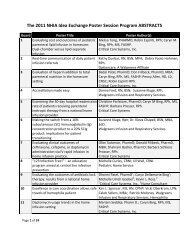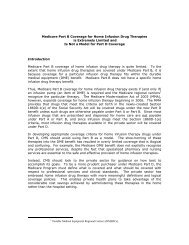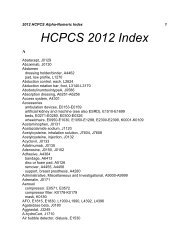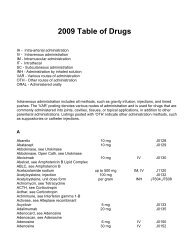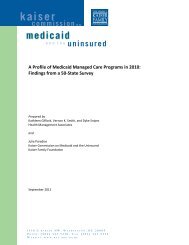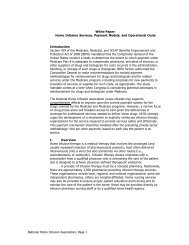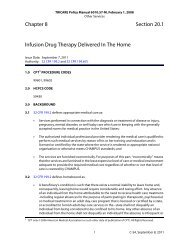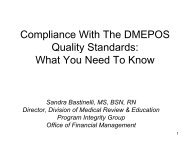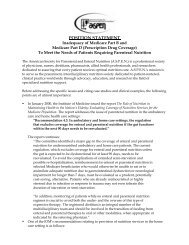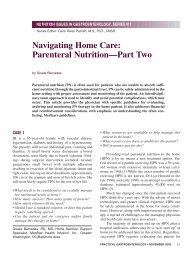IgG Therapy for the Home-Based Patient: Administration and ... - NHIA
IgG Therapy for the Home-Based Patient: Administration and ... - NHIA
IgG Therapy for the Home-Based Patient: Administration and ... - NHIA
Create successful ePaper yourself
Turn your PDF publications into a flip-book with our unique Google optimized e-Paper software.
tolerated <strong>and</strong> noticeably free of adverse reactions. 5 This<br />
study paved <strong>the</strong> way <strong>for</strong> additional research in both adult<br />
<strong>and</strong> pediatric patients—largely with positive results. By<br />
1981, <strong>the</strong> safe <strong>and</strong> effective home administration of SCIG<br />
was first reported. 6 Subsequent studies reported similar success<br />
with varying rates of administration. 7,8,9<br />
Despite <strong>the</strong>se innovations, <strong>the</strong> subcutaneous (SC) method<br />
of <strong>IgG</strong> administration did not take hold in <strong>the</strong> U.S., largely due<br />
to <strong>the</strong> availability of IVIG <strong>and</strong> <strong>the</strong> fact that <strong>the</strong>re was no commercial<br />
product specifically <strong>for</strong>mulated <strong>for</strong> SC delivery. That<br />
changed in 2006, when <strong>the</strong> FDA approved <strong>the</strong> first <strong>IgG</strong> <strong>for</strong>mulation<br />
designed exclusively <strong>for</strong> subcutaneous administration. 10<br />
Since <strong>the</strong>n, three additional SCIG <strong>for</strong>mulations have been FDA<br />
approved <strong>for</strong> primary immunodeficiency—with o<strong>the</strong>rs currently<br />
in clinical trials. The subcutaneous administration of IVIG<br />
<strong>for</strong>mulations has also become more widespread.<br />
To date, few studies have been conducted to directly<br />
compare IVIG <strong>and</strong> SCIG. However, sufficient available research<br />
has shown that, due to its relatively stable bioavailability,<br />
SCIG is associated with fewer systemic adverse<br />
events. 11 In addition, this administration route offers a variety<br />
of advantages to patients who are willing to commit<br />
to selfadministration.<br />
SCIG <strong>Patient</strong> Selection<br />
SCIG offers several advantages over intravenous administration.<br />
Chief among <strong>the</strong>m is a viable treatment alternative <strong>for</strong><br />
patients with limited vascular access or those who cannot tolerate<br />
<strong>the</strong> side effects commonly associated with IV administration.<br />
The slower administration <strong>and</strong> gradual absorption of SCIG<br />
eliminates rapid, large variances in serum <strong>IgG</strong> levels, which reduces<br />
adverse affects, such as migraines, <strong>and</strong> <strong>the</strong> need to premedicate<br />
prior to infusion. In addition, consistent serum levels<br />
achieved through this <strong>the</strong>rapy modality eliminate low trough<br />
levels, <strong>the</strong>reby reducing associated symptoms, such as extreme<br />
fatigue, joint pain, swelling, <strong>and</strong> malaise. 11<br />
SCIG also offers greater flexibility <strong>and</strong> patient autonomy. Although<br />
<strong>the</strong> fractionated doses require weekly—or more frequent—infusions,<br />
patients often enjoy <strong>the</strong> flexibility of being<br />
SCIG at a Glance<br />
Advantages<br />
• No IV access necessary<br />
• Fewer systemic side effects, no need to premedicate<br />
• Fewer systemic effects resulting from peak <strong>and</strong><br />
trough variability<br />
• <strong>Patient</strong> flexibility/autonomy<br />
Disadvantages of SCIG<br />
• Requires commitment <strong>and</strong> compliance<br />
• Not appropriate <strong>for</strong> large volume <strong>the</strong>rapies or very<br />
lean patients<br />
• Requires more frequent infusions<br />
• Local infusion reactions can occur<br />
<strong>IgG</strong> <strong>Therapy</strong> <strong>for</strong> <strong>the</strong> <strong>Home</strong><strong>Based</strong> <strong>Patient</strong>: <strong>Administration</strong> <strong>and</strong> Delivery Method Considerations 3



